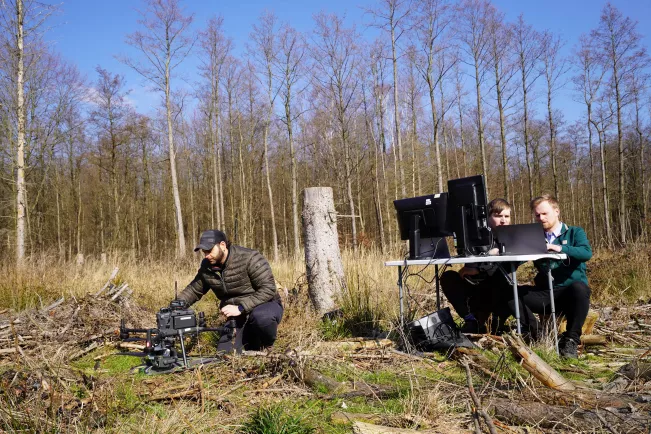Communications and Marketing
Reforestation with drones: H-BRS project Garrulus enters final project phase

Since the 1970s, Forest Day on 21 March has been a reminder that our forests are a precious resource on whose preservation our future depends. Today, almost 50 years later, the topic is still relevant. According to the Federal Ministry of Food and Agriculture (BMEL), four out of five trees in Germany are diseased. Many tree sections had to be felled in the fight against the bark beetle. However, the reforestation of already destroyed forest areas is very expensive and can only be realised with a considerable amount of time and manpower.
In the Garrulus project, scientists from the UAV Lab at H-BRS are endeavouring to simplify this work. The finished prototype, an autonomously flying drone, should be able to measure the damaged terrain, quantify the extent of the damage and sow new seeds in suitable locations.
Measuring drone flies over area independently
"Our measuring drone flies over the area independently and creates very high-resolution maps from the data obtained. These are the basis for the development of our machine learning models, which form the centrepiece of our research," says Ahmad Drak, Project Manager at H-BRS.
The system uses artificial intelligence to find suitable locations where the tree seed has the best possible chance of growing. In order to obtain the necessary information about what a tree needs to grow optimally, the team works together with experts: "We can turn to the Landesbetrieb Wald und Holz NRW for all forestry questions, which provides us with excellent support," says Drak.
Patent for the sowing mechanism
In order to realise the planting from the air, the researchers have developed a sowing mechanism that is attached to the drone. This technical solution, which has now been patented, is now to be further improved during tests in the field. The research trips required for this, for example to the Kottenforst forest in Bonn or a forest area in Arnsberg, are very important for the team: "As computer scientists, we naturally spend most of our time at the computer. The practical tests in the destroyed forest areas are very time-consuming, but here we experience very impressively what we work for every day. We want to use our technical expertise to preserve nature," says Drak.
The Garrulus research project is being carried out by researchers from the Institute for Technology, Resource and Energy-efficient Engineering (TREE). It is funded by the Ministry of Agriculture and Consumer Protection NRW.
Press photo: Practical test in the Kottenforst: Ahmad Drak, Brennan Penfold and Max Johenneken (from left). Photo: Pascal Schröder/H-BRS
Contact

Location
Sankt Augustin
Room
A 035
Address
Grantham-Allee 20
53757, Sankt Augustin

Pascal Schröder
Project management for the further development of the university website
Location
Sankt Augustin
Room
E 241
Address
Grantham-Allee 20
53757, Sankt Augustin
Telephone
+49 2241 865 9969